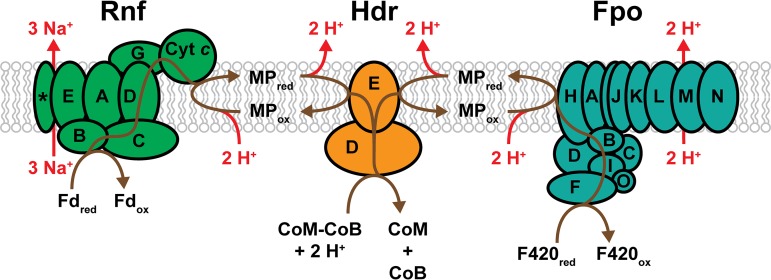FIG 6.
The H2-independent electron transport system of Methanosarcina. Electrons enter the transport system as either reduced coenzyme F420 or reduced ferredoxin and are used for the reduction of the terminal electron acceptor, CoM-CoB. Reduction of CoM-CoB by the heterodisulfide reductase regenerates CoM and CoB for continued methanogenesis. F420 dehydrogenase (Fpo) catalyzes the exergonic transfer of electrons from F420red to MP with concomitant translocation of 2 H+ ions to the outside of the cell. Similarly, the Rnf enzyme complex facilitates the exergonic transfer of electrons from Fdred to MP, but instead translocates 3 Na+ ions outside of the cell. In both pathways, an additional 2 H+ ions are consumed from the cytoplasm during MP reduction and released outside of the cell upon MP oxidation. Thus, the transport of 2 electrons results in 4 H+ ions translocated for the F420red:CoM-CoB pathway and 3 Na+ plus 2 H+ ions translocated for the Fdred:CoM-CoB pathway (indicated in red). Brown lines trace the putative pathways of electron transport. Enzyme subunits are identified by letters, with the exception of the cytochrome c subunit (Cyt c) and a membrane-integral subunit with unknown function (*) that are cotranscribed with the rest of the rnf operon.

